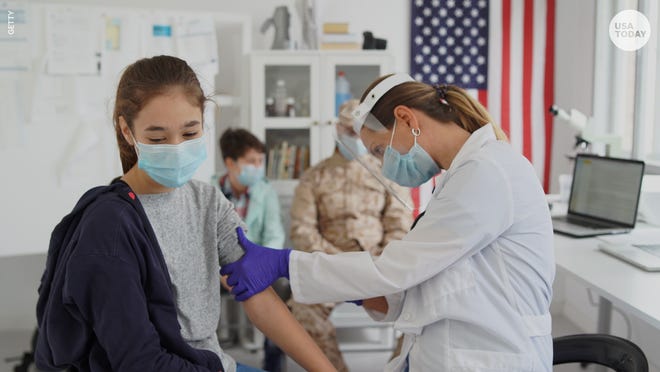Encouraging data on the effectiveness and safety of COVID-19 vaccines for kids is a welcome sign for summer vaccinations and the 2021-22 school year that will begin in little more than three months for some of the nation’s districts.
The good numbers also could ignite much-needed momentum in the lagging national vaccination effort, experts say.
Moderna reported Thursday that its vaccine is showing a 96% effectiveness rate in Phase 2/3 testing ofadolescents ages 12 to 17. Pfizer has reported its COVID-19 vaccine was 100% effective in a study of adolescents ages 12 to 15. Emergency use authorization for its vaccine is expected soon.
Dr. David Hirschwerk, an infectious diseases expert at Northwell Health in Manhasset, New York, called the Moderna results “excellent,” saying they reflect the high level of effectiveness and safety he hopes will encourage young people to get vaccinated.
“Widespread vaccination among school-age children will clearly allow for a far more normalized school experience,” he said.
Pfizer asks FDA to OK its vaccine for kids ages 12-15
Moderna, which provided the information in a financial report, said the vaccine was generally well tolerated by the kids who received it. The majority of “adverse events” were mild or moderate in severity, the company said. The most common was injection-site pain, although there were some reports of other minor symptoms.
“No serious safety concerns have been identified to date,” the report said. The most common problems after a second dose were headache, fatigue, muscle ache and chills, the report said.
The company is still collecting data. It also noted that its Phase 2 “KidCOVE” study in kids ages 6 months to 11 years is ongoing.
States prepare for long grind as demand for COVID-19 vaccinations in US slows
The data comes as the nationwide vaccination drive goes through a “lag phase,” said Ogbonnaya Omenka, an associate professor and public health specialist at Butler University in Indianapolis. Daily vaccinations have declined in recent weeks, a phenomenon Omenka described as normal, particularly in the days after the Johnson & Johnson one-shot vaccine was paused because of concerns about blood clots.
“Also, vaccine uptake can stall, ironically, because of the uptake of the vaccine on a large scale,” Omenka said. “This is analogous to the ‘bystander effect,’ where everyone assumes that someone is going to respond to a need, and in many cases the need goes either unmet or not fully met.”
Translation: When many people get vaccinated, some people might assume they do not need to be vaccinated. That may delaying herd immunity or even prevent it, he said. Bystander effect is one of the reasons why the social and behavioral aspects of confronting threats to the population have proved to be the most challenging.
Omenka said the latest data could help curb broader vaccine hesitancy, which has been partly to blame for a slowdown in daily shots.
“This is definitely great news because it would give us a chance to expand the size of the population that can be inoculated,” Omenka said. “This has positive implications, including demonstrating the safety of the vaccines and their effectiveness across a larger sample of the population.”
Tipping point: Dramatic decrease in COVID-19 cases could come without herd immunity
But translating the good news into increased vaccination rates will still take work, he said. The importance of effective public health messaging can’t be overemphasized, he added.
“Predictably, expanding the vaccinated population would bolster our herd immunity efforts,” he said. “At the same time, it is important to point out the need for us to keep being mindful about how we frame the role of herd immunity in our push to get over this pandemic. Herd immunity is not the end goal.”
Rather, he said, it is an essential tool “in our response kit” that allows us to push the disease at least to where it becomes a sort of “background noise,” at most to the ultimate goal of eradicating it.
Hirschwerk concurs. Strong vaccine programs have shown to suppress infection rates, he said.
“I’m not sure that we will ever reach herd immunity,” he said. “But it remains clear that the more people vaccinated, the lower the rates become in the community, and the safer we all are.”
